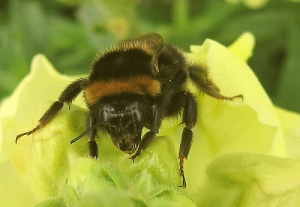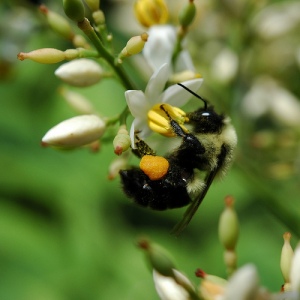 It is likely to come as a surprise to most non-entomologists that there are around 250 species of bumblebee, and that the UK has 24 native bumblebee species including the rare Shrill Carder Bombus sylvarum and Great Yellow Bombus distinguendus, both of which are under threat of national extinction (two other species have gone extinct in the UK in the last 70 years).
It is likely to come as a surprise to most non-entomologists that there are around 250 species of bumblebee, and that the UK has 24 native bumblebee species including the rare Shrill Carder Bombus sylvarum and Great Yellow Bombus distinguendus, both of which are under threat of national extinction (two other species have gone extinct in the UK in the last 70 years).
Aside from providing us with honey and wax, bees and many other insect perform an essential ecosystem function estimated to be worth $14.2 billion in 2005 within the EU25 countries – the pollination of our crops and other plants. In addition, some wild plant species can only be pollinated by bumblebees. Changing land use, however (such as the cessation of crop-rotation, destruction of hedgerows, and increased use of pesticides), has put many pollinators under threat, and bumblebees are no exception.
Although each nest contains 50-400 bumblebees, the effective population (which only counts those members that can breed and so contribute directly to the next generation) is only around 1.5 per nest, because the queen bumblebee is the only members of the nest who can produce offspring (and she is fertilised by a single male who has just one set of chromosomes, termed haploid). Bumblebees eat pollen and nectar and where their preferred plants are at low density their nests can be sparsely distributed, resulting in low effective population densities in many preserved area, that are not self-sustainable in the long-term.
are not self-sustainable in the long-term.
Conservationists, therefore, have realised we cannot rely solely upon nature reserves to keep bumblebee species extant (surviving). For once, each one of us who owns a garden or allotment can make a direct and significant contribution to conservation by planting bee-friendly plant species, such as heather, foxglove and lavender – and as bees are umbrella species, simultaneously you will be conserving less pretty, but no less deserving, other bugs.
Find out more about what you can do personally to keep our bumblebee species alive at The Bumblebee Conservation Trust – you can even contribute to science by reporting which bumblebee species visit your garden.
References
Goulson D et al. 2011. Translating research into action; bumblebee conservation as a case study. Journal of Applied Ecology 48: 3-8
Further Information
– The Bumblebee Conservation Trust
– BugLife
– Hymettus Ltd
– Bees, Wasps and Ants Recording Society
– Xerces Society
– Bumblebee.org
– Bees and Chicks
– Bumblebee videoclips – BBC

